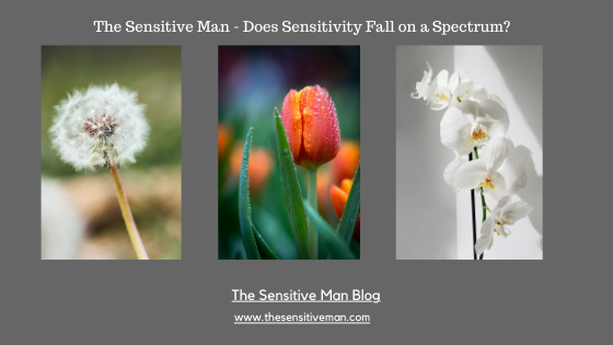|
A Blog about Sensory Processing Sensitivity from the Worldview of a High Sensing Male Like most personality traits, I have often wondered whether Sensory Processing Sensitivity (SPS) falls on a spectrum. And if so, is it possible for us to move up and down on the spectrum with life experience and age? If the trait is even moderately fluid, how would that affect highly sensitive people? Lately, a developmental model for children has gained some traction in describing sensitivity generally in all people. It uses a simple flower metaphor to describe the degree to which individuals adapt to or are affected by the environment. Dandelions, known for their hardiness, represent the most adaptable yet least sensitive individuals. Next is represented by tulips, which are the broad middle ground of people that fall on the broadest spectrum of adaptability and resiliency. Finally, there are the orchids, beautiful flowers, but ones that require the most significant attention and support. Both dandelions and orchids represent the two smallest population groups and are opposites. HSPs fall into the orchid group – no surprise there. Many of the foundational characteristics of this typology are genetically based. Some would argue that sensitivity is a well-established personality trait that remains stable over time. I agree that most HSPs are likely to remain consistently along the high end of the curve for sensitivity, which would not fluctuate drastically. But I wonder if the effects of environment and experience could not alter, even slightly, the degree of sensitivity we have over time. Let's examine this. Personality Theory on a Rope Most personality theorists would argue that personality traits tend to distribute on a continuum. Personality traits are recognizable aspects of an individual shown in various social and personal contexts that manifest in behavioral choices. Allport suggested that traits fall into a hierarchy from Cardinal (dominant traits) to Central (prominent characteristics) to Secondary (situational traits). We might assume that SPS would fall into the cardinal bucket, considering its influences on the HSP personality. Cattrell condensed the Allport theory and argued that individual differences influenced traits. He proposed a model of traits that employed a continuum to express each trait's "degreeness." Many of these traits proposed are described with polar opposites - high/low endpoints on the continuum (see Flower Model) with the largest representation in the middle. Later development of the Big Five Personality theory, which has considerable evidence-based validation, acknowledges that while personality traits are relatively stable over a lifetime, there is still some tendency to increase or decrease as life is experienced. This evidence supports the idea of a continuum of personality traits, with some degree of fluidity. However, it is essential to recognize that in some cases change comes as a function of the individual’s experience and not necessarily a function of the trait itself. How do SPS individuals stack up? Within the trait of SPS, is there some differentiation amongst the group? In other words, do highly sensitive people fall into a high highly sensitive grouping, a medium highly sensitive grouping, and a low highly (oxymoron?) sensitive grouping? If we look back at the Flower model, the suggestion that general sensitivity is a spectrum, from low to high, and that there is demarcation to separate groups along a bell-shaped distribution curve, could there not be a similar distribution within each distinct group? Could those individuals within the high sensitivity group also be broken down into finer buckets to delineate their degree of sensitivity? I think so. Environment plays a critical role in personality development, which enhances or detracts from personality traits and creates a wide swath of individual differences within humans. Life experiences might also increase or decrease how qualities are expressed over time, although not likely in large increments. Gene expression is often influenced by extrinsic environmental factors, which has given rise to the new field of epigenetics (See Bruce Lipton). Why could personality traits, which have a large genetic component, not also be affected by life, environment, and individual experience? Is there variability with the SPS trait? Some psychologists describe SPS in terms of overexcitabilities, or vividly lived experiences (see BLOG on Positive Disintegration Theory). A typology has emerged which classifies HSP individuals into five distinct groups – 1) Psychomotor (energetic leaning), 2) Sensual (sensory focused), 3) Intellectual (thinkers), 4) Imaginational (idea magnets, fantasy focused), and 5) Emotional (empathetic). The groups suggest variabilities within HSPs, and if you consider combinations of types within a single individual, you increase the variability as hybrids. Is there a polarity within the trait of sensitivity? It's interesting to think of the idea of a degree of sensitivity that could be measured along the line of empathy. For example, could there be a sensitivity dimension, tied to empathy, that ends with positive and negative poles of sensitivity? Positive sensitivity would represent HSP individuals with high degrees of empathy and sensitivity, and negative sensitivity might be low sensitive individuals with a corresponding low degree of empathy. Or could there be a polar end with negative sensitivity representing the spectrum where narcissists fall, with no empathy yet may be highly sensitive to criticism or other environmental cues? What about a dimensionality of sensing that might be measured along a line of adaptability or functionality, such as a low functioning sensitive or a high functioning sensitive individual? Not to suggest that HSPs are dysfunctional, but some with SPS do struggle with the trait. Is there a way to measure sensitivity on a scale? At present, I am not aware of a test for SPS that measures the degree to which you possess the trait. Dr. Aron's test, the current benchmark for sensitivity, does measure whether you likely are a highly sensitive person, but not necessarily to the degree, you have the trait. I understand that she is developing another test for SPS, so we can all look forward to that. Once we have something that can measure the degree of SPS, perhaps, we can test the trait's stability over time. That is if we do experience fluidity of the trait over our lifetimes. With that type of test, I also wonder if learning to throttle some of the traits would help moderate some aspects of SPS that may be uncomfortable. Although this type of testing may not be on the horizon, it might help with raising HSP children, counseling HSP individuals, and giving HSPs a way of measuring their trait depth. Depth, yeah, that's something HSPs would be interested in… Please share your thoughts in the comment section.
0 Comments
Leave a Reply. |
AuthorBill Allen currently lives in Bend, Oregon. He is a certified hypnotist and brain training coach at BrainPilots.com. He believes that male sensitivity is not so rare, but it can be confounding for most males living in a culture of masculine insensitivity which teaches boys and men to disconnect from their feelings and emotions. His intent is to use this blog to chronicle his personal journey and share with others. Archives
July 2024
Categories
All
|



 RSS Feed
RSS Feed
